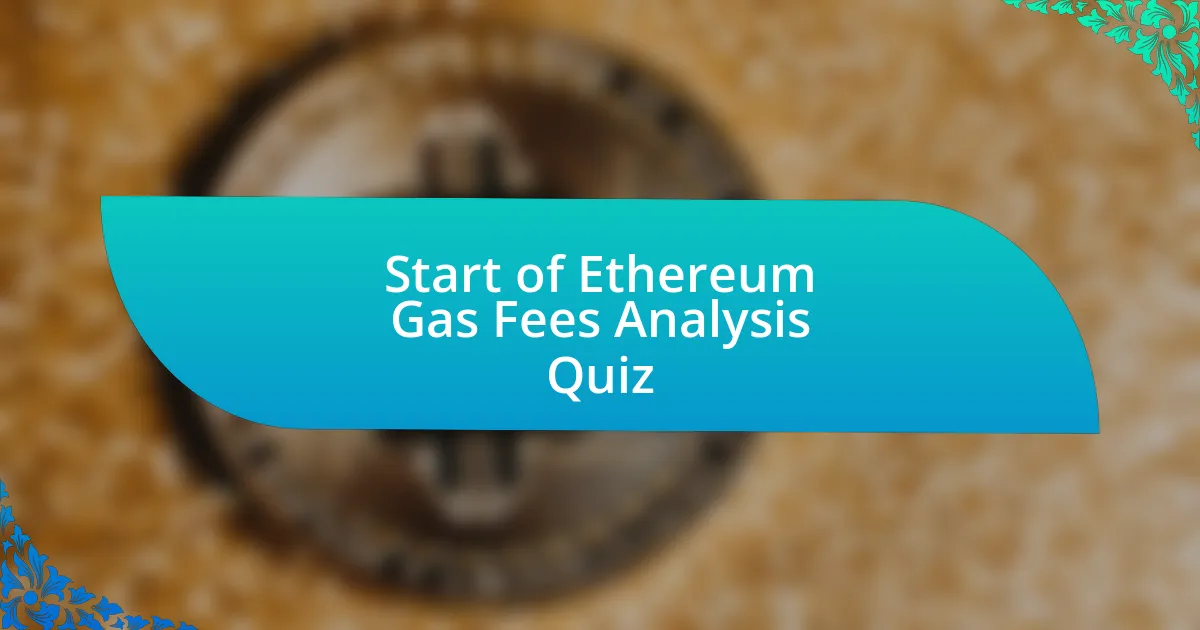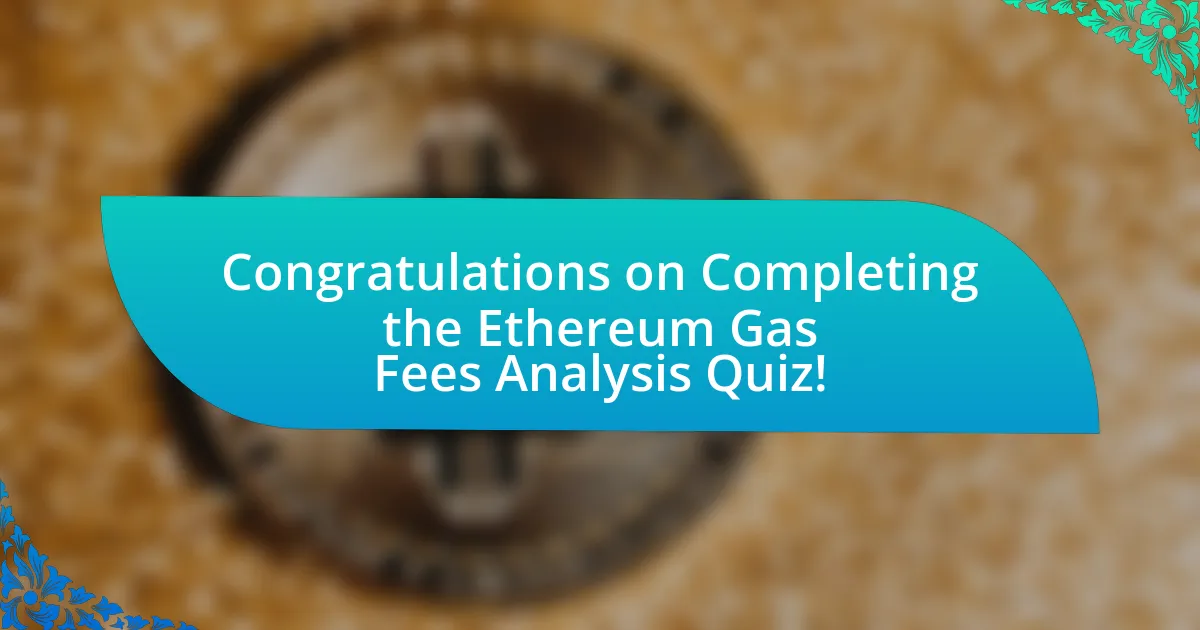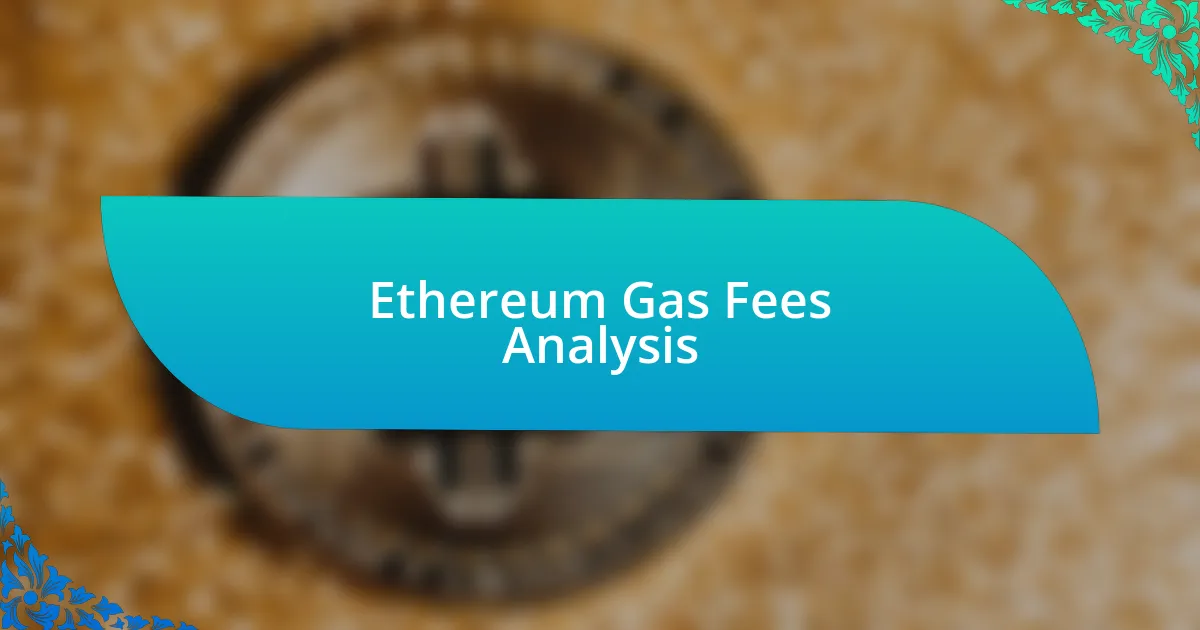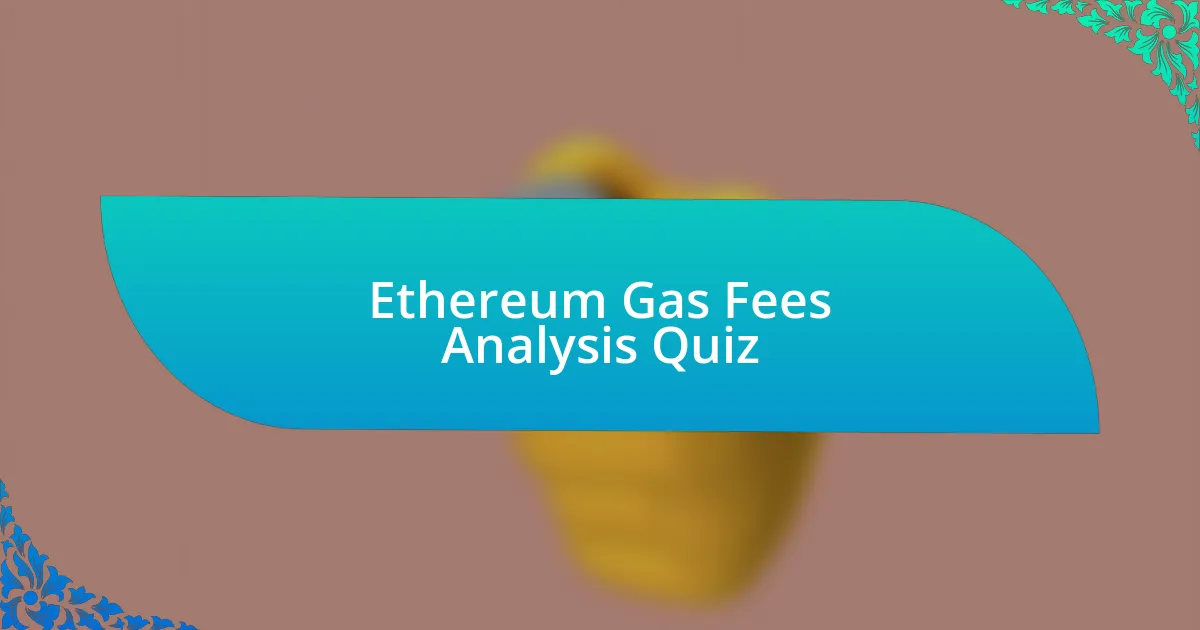
Start of Ethereum Gas Fees Analysis Quiz
1. What is Ethereum gas?
- A special feature that enhances Ethereum`s security.
- A protocol for creating decentralized applications.
- A type of cryptocurrency used exclusively for trading.
- The fee required to successfully conduct a transaction or execute a contract on the Ethereum blockchain platform.
2. How are Ethereum gas fees priced?
- Based solely on the size of the transaction data.
- In fixed amounts of fiat currency.
- In tiny fractions of ether called gwei.
- In varying percentages of total ETH holdings.
3. What are gwei?
- Gwei are types of Ethereum wallets used for storing funds.
- Gwei are large denominations of Bitcoin used for trading.
- Gwei are billionths of an ETH, used to express gas charges.
- Gwei are units used to measure the speed of blockchain transactions.
4. What factors determine the exact price of gas?
- Only the number of users online at the moment.
- Supply, demand, and network capacity at the time of the transaction.
- The geographical location of the user making the transaction.
- The time of day regardless of network conditions.
5. What happens to gas prices when the network is congested?
- Gas prices decrease when the network is congested.
- Gas prices only increase when demand is low.
- Gas prices remain unchanged when the network is congested.
- Gas prices might be high when the network is congested.
6. How are gas fees calculated before the London upgrade?
- Gas fee = Gas units (limit) / Gas price per unit.
- Gas fee = Gas units (limit) * Gas price per unit.
- Gas fee = Gas units (used) + Gas price per unit.
- Gas fee = Gas price per unit – Gas units (limit).
7. What is the minimum number of gas units required for a transaction?
- 5,000 gas units
- 15,000 gas units
- 21,000 gas units
- 30,000 gas units
8. What is the base fee in the new gas fee calculation after the London upgrade?
- A set fee for the transaction set by the network.
- A fixed fee regardless of conditions.
- A fee determined by gas units only.
- A variable fee based on transaction speed.
9. What is the priority fee in the new gas fee calculation after the London upgrade?
- A fixed fee that applies to every user of the network.
- A tip to the validator that chooses a transaction to process it faster.
- A mandatory tax for all Ethereum transactions.
- A charge imposed by the Ethereum Foundation for transaction approval.
10. How are gas fees calculated after the London upgrade?
- Gas fee = Gas units (limit) * (base fee + priority fee).
- Gas fee = Gas units (limit) + (base fee * priority fee).
- Gas fee = (Gas price per unit + base fee) * Gas units (limit).
- Gas fee = Gas units (limit) – (priority fee / base fee).
11. What happens to the base fee in the new gas fee calculation?
- The base fee is burned to reduce the amount of ETH in circulation.
- The base fee is paid directly to miners as a reward.
- The base fee is eliminated completely from transactions.
- The base fee increases unpredictably during high demand.
12. What is the purpose of the priority fee in the new gas fee calculation?
- To calculate the total cost for executing a smart contract.
- To assess the network`s overall performance during transactions.
- To determine the maximum gas limit allowed for a transaction.
- To incentivize validators to prioritize transactions and process them faster.
13. How can users avoid high gas fees?
- By always paying double the gas fee.
- By using the Ethereum blockchain only on weekends.
- By sending all transactions as fast as possible.
- By choosing times when the network is not busy.
14. What tools can users use to track gas prices in real-time?
- Spotify and fuel cost estimators
- EtherScan and gas trackers
- Google Maps and gas apps
- Amazon and gas calculators
15. How do Layer 2 solutions help reduce gas fees?
- By taking transactions off the main chain, thereby reducing the load on the main network.
- By adding more complex fees for each transaction on the main chain.
- By requiring more gas units for every transaction processed.
- By increasing the number of miners available to process transactions.
16. What are some examples of Layer 2 solutions?
- Bitcoin
- Dogecoin
- Litecoin
- Arbitrum
17. Why do gas fees increase with network demand?
- Because only large transactions require higher fees than small ones.
- Because the network wants to penalize users for participating.
- Because more traffic requires more resources, increasing the demand for validators and thus the fees.
- Because transaction fees are fixed regardless of demand.
18. How does the execution level (Ethereum 1.0) differ from the consensus level (Ethereum 2.0) in terms of gas fees?
- In Ethereum 1.0, fees are non-refundable, while in Ethereum 2.0, fees can be refunded.
- In Ethereum 1.0, fees are fixed, while in Ethereum 2.0, fees vary per transaction.
- In Ethereum 1.0, fees are paid by users, while in Ethereum 2.0, fees are absorbed by the network.
- In Ethereum 1.0, fees go to miners, while in Ethereum 2.0, fees go to ETH stakers.
19. What is the relationship between gas units and gas price in calculating gas fees?
- The gas fee is the product of the gas units and the gas price.
- The gas fee is always fixed regardless of gas units.
- The gas fee is based only on the time of day transactions are made.
- The gas fee is determined solely by the transaction size.
20. How can users determine the gas fee without using trackers or calculators?
- By asking other users what their fees were for similar transactions.
- By assuming a gas price and multiplying it by the minimum number of gas units required for the transaction.
- By checking historical transaction fees on a blockchain explorer.
- By guessing the fee based on previous transactions without any calculation.
21. What is the formula to calculate gas fees using a gas fee calculator?
- Units of Gas Used + Base Fee + Priority Fee.
- Gas Units Used – (Base Fee + Priority Fee).
- Gas Price / (Gas Units Used + Base Fee + Priority Fee).
- Units of Gas Used * (Base Fee + Priority Fee).
22. How does the base fee affect gas fees?
- The base fee has no impact on gas fees and is irrelevant to transactions.
- The base fee is a minimum price for gas determined algorithmically based on real demand for blockspace.
- The base fee is set by individual users to prioritize their transactions.
- The base fee is a flat fee that never changes regardless of demand.
23. What is the purpose of the final (priority) fee in gas fee calculation?
- To set a fixed fee for all transactions based on their complexity.
- To circumvent network congestion and ensure faster transaction processing.
- To calculate the minimum fee required for a transaction.
- To determine the block size for transactions in the network.
24. How do complex transactions affect gas fees?
- Complex transactions lower gas fees, benefiting users by making them more affordable.
- Complex transactions have no effect on gas fees at all; they remain the same.
- Complex transactions, such as executing smart contracts, may incur higher gas fees than simpler transactions like sending ETH.
- Complex transactions reduce gas fees, making transactions cheaper overall.
25. What is the relationship between gas fees and Ethereum network upgrades?
- Network upgrades will always reduce gas fees to a flat rate for all transactions.
- Network upgrades have no impact on gas fees whatsoever.
- Network upgrades only increase gas fees without any other changes.
- Network upgrades can change how gas fees are calculated and improve predictability.
26. How do gas fees compare to transaction fees on other blockchains?
- Gas fees on Ethereum are significantly less than transaction fees on most other established blockchains.
- Ethereum gas fees tend to be higher due to the complexity of the network but offer more versatility for various uses.
- Gas fees on Ethereum are generally lower than those on newer blockchains with simpler structures.
- Transaction fees on Ethereum are fixed and do not vary based on network traffic.
27. What strategies can users employ to minimize Ethereum gas fees?
- Relying solely on market speculation for gas prices.
- Ignoring the time of day the transaction is executed.
- Using high-value transactions regardless of network load.
- Transacting during low-traffic times, using Layer 2 solutions, and adjusting wallet settings.
28. How does the Ethereum network`s history and value impact gas fees?
- Gas fees decrease regardless of network activity or transaction complexity.
- The higher gas fees are often justified by Ethereum`s history as a major player and its versatility, making it worth the cost to many users.
- Gas fees are only determined by the amount of ETH a user holds.
- Gas fees remain constant due to Ethereum`s fixed pricing model.
29. What tools can users install to track gas prices in real-time?
- Tools like EtherScan`s Chrome extension.
- Applications like Bitcoin Tracker`s mobile app.
- Websites like Cardano Price Tracker platform.
- Services like Ripple Rates Dashboard.
30. How can users ensure they pay enough gas for a transaction to be processed promptly and successfully?
- By ignoring network congestion and setting random gas prices.
- By setting a sufficient gas limit and gas price, and considering the complexity of the transaction.
- By only using the minimum gas limit regardless of the transaction.
- By always selecting the highest gas limit for every transaction.

Congratulations on Completing the Ethereum Gas Fees Analysis Quiz!
Well done on finishing the quiz! You’ve taken a significant step in understanding Ethereum gas fees. These fees play a crucial role in transactions and network performance. Through this quiz, you likely learned how gas prices fluctuate and the factors influencing them. Understanding these elements is essential for anyone engaged in the Ethereum ecosystem.
Throughout the quiz, you may have discovered strategies to minimize gas fees. You also learned about the impact of network congestion and the importance of timing your transactions. These insights can help you make smarter choices when transacting on the Ethereum network. It’s not just about the technology; it’s about using that knowledge effectively.
If you’re eager to dive deeper into this topic, we invite you to explore the next section on Ethereum Gas Fees Analysis. This resource will expand on what you’ve learned and provide more in-depth knowledge on the subject. Understanding gas fees can significantly enhance your experience with Ethereum, so don’t miss out on this opportunity to grow your understanding!

Ethereum Gas Fees Analysis
Understanding Ethereum Gas Fees
Ethereum gas fees refer to the costs incurred to execute transactions or run applications on the Ethereum blockchain. These fees are paid in Gwei, which is a denomination of Ether (ETH). Gas is required to process transactions and smart contracts, compensating miners for their computational efforts. The amount of gas needed depends on the complexity of the transaction or contract. As network activity increases, these fees can become volatile, affecting user behavior and overall network usage.
Factors Influencing Ethereum Gas Fees
Ethereum gas fees are influenced by several key factors. Network congestion plays a major role; more users competing for limited block space leads to higher fees. The complexity of the transaction also affects the fee; more intricate smart contracts require more computational power to execute. Additionally, users can set their own gas prices, impacting the speed of their transaction. This dynamic marketplace for gas fees can result in significant fluctuations.
Gas Fee Structures and Pricing Mechanisms
The Ethereum gas fee structure is primarily based on two components: the gas limit and the gas price. The gas limit is the maximum amount of gas a user is willing to pay for a transaction, while the gas price is the amount of Gwei per unit of gas. The total fee for a transaction is calculated by multiplying both values. Users often refer to recommended gas prices listed on various platforms to estimate the current market rate, which can guide transactions for efficiency.
Trends in Ethereum Gas Fees Over Time
Analyzing historical data reveals trends in Ethereum gas fees. Gas fees typically spike during periods of high network usage, such as during significant events or popular Initial Coin Offerings (ICOs). Periods of lower activity often correlate with decreased fees. Observing these trends helps users anticipate potential costs and plan their transactions accordingly. Tools and dashboards are available to provide real-time data on gas prices, significantly aiding users in fee management.
Impact of Ethereum Upgrades on Gas Fees
Ethereum upgrades, such as the London Hard Fork, have directly affected gas fees. The London Hard Fork introduced EIP-1559, which changed how gas fees are calculated. This update implemented a base fee system, making fees more predictable and reducing spikes during high demand. Subsequent upgrades aim to improve network scalability and efficiency, further influencing gas fee dynamics. Monitoring these developments is essential for understanding future gas fee trends.
What are Ethereum gas fees?
Ethereum gas fees are the costs required to execute operations on the Ethereum blockchain. These fees compensate miners for processing transactions and executing smart contracts. Gas fees are measured in Gwei, which is a fraction of Ether (ETH). Fee amounts can fluctuate based on network demand and complexity of the transaction. In periods of high demand, such as during significant market events, gas fees can rise substantially, sometimes exceeding hundreds of dollars for a single transaction.
How are Ethereum gas fees calculated?
Gas fees are calculated based on two main components: gas limit and gas price. The gas limit refers to the maximum amount of gas that a transaction can use, while the gas price indicates how much the sender is willing to pay per unit of gas. The total fee is computed by multiplying the gas limit by the gas price. For example, if a transaction has a gas limit of 21,000 and a gas price of 100 Gwei, the total fee would be 2,100,000 Gwei, or 0.0021 ETH.
Where can Ethereum gas fees be monitored?
Ethereum gas fees can be monitored on various cryptocurrency tracking websites and platforms, such as EthGasStation, Gas Now, and Etherscan. These platforms provide real-time data on the current gas prices, average transaction speeds, and historical fee trends. Users can see different gas price tiers—low, average, and high—allowing them to choose optimal times for executing transactions.
When do Ethereum gas fees spike?
Ethereum gas fees typically spike during periods of high network congestion. This can occur during significant market movements, the launch of popular decentralized applications (dApps), or events like non-fungible token (NFT) drops. For instance, the fees surged in May 2021 when NFT trading volumes skyrocketed. Such activities create competition for block space, driving fees up as users are willing to pay more for faster transaction confirmation.
Who benefits from Ethereum gas fees?
Miners and validators benefit from Ethereum gas fees as they are rewarded for processing transactions and securing the network. The fees are paid directly to them for their computational efforts. Additionally, dApp developers may benefit indirectly through increased user activity, as higher gas fees can lead to greater demand for their services and products, depending on the value provided to users.

